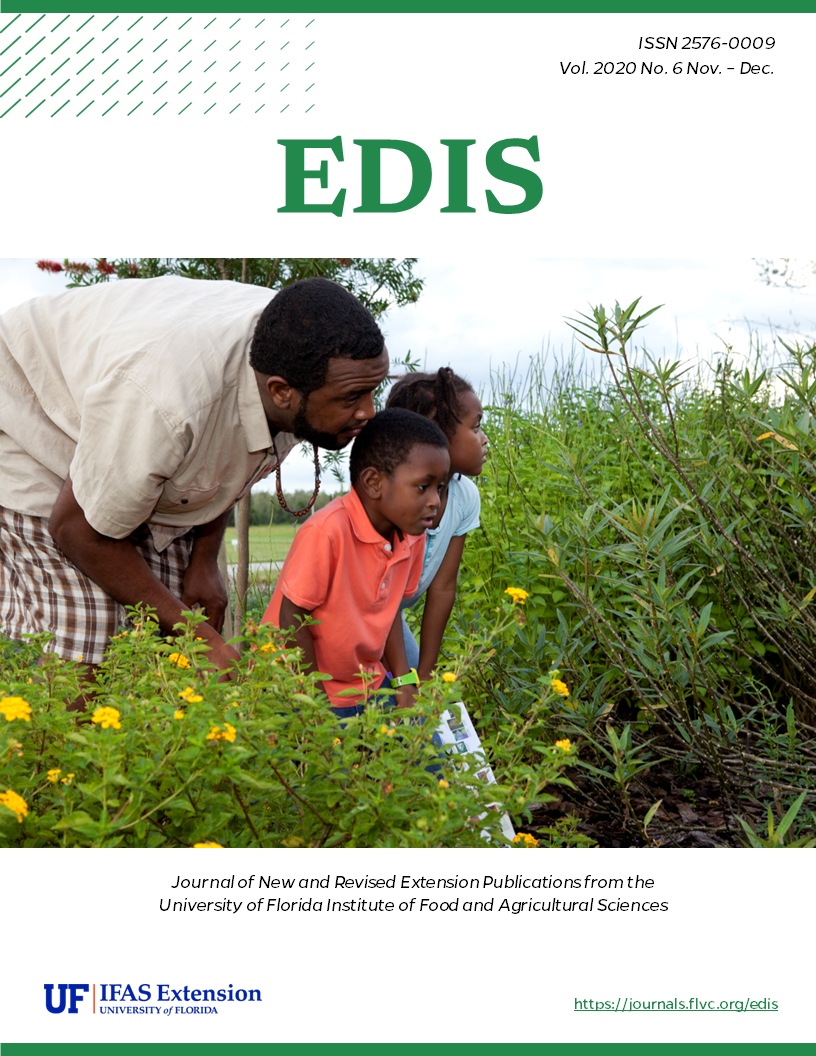Abstract
The muscadine grape is native to the southeastern United States and was the first native grape species to be cultivated in North America. The natural range of muscadine grapes extends from Delaware to central Florida and occurs in all states along the Gulf Coast to east Texas. It also extends northward along the Mississippi River to Missouri. Muscadine grapes will perform well throughout Florida, although performance is poor in calcareous soils or in soils with very poor drainage. Most scientists divide the Vitis genus into two subgenera: Euvitis (the European, Vitis vinifera L. grapes and the American bunch grapes, Vitis labrusca L.) and the Muscadania grapes (muscadine grapes). There are three species within the Muscadania subgenera (Vitis munsoniana, Vitis popenoei and Vitis rotundifolia). Euvitis and Muscadania have somatic chromosome numbers of 38 and 40, respectively. Vines do best in deep, fertile soils, and they can often be found in beside river beds.
Wild muscadine grapes are functionally dioecious due to incomplete stamen formation in female vines and incomplete pistil formation in male vines. Male vines account for the majority of the wild muscadine grape population. Muscadine grapes are late in breaking bud in the spring and require 100-120 days to mature fruit. Typically, muscadine grapes in the wild bear dark fruit with usually 4 to 10 fruit per cluster. Bronze-fruited muscadine grapes are also found in the wild, and they are often referred to as scuppernongs. There are hundreds of named muscadine grape cultivars from improved selections, and in fact, one that has been found in the Scuppernong river of North Carolina has been named Scuppernong. There are over 100 improved cultivars of muscadine grapes that vary in size from 1/4 to 1 ½ inches in diameter and 4 to 15 grams in weight. Skin color ranges from light bronze to pink to purple to black. Flesh is clear and translucent for all muscadine grape berries.
Originally published 1994 by Peter C. Anderson and Timothy E. Crocker. Published on EDIS June 2003. Revised November 2010, October 2013, January 2017. This revision with Sarkhosh and Huff.
References
Andersen, P. C. 1992. "Performance of Cultivars and Selections of Muscadine Grapes in North Florida." Fruit Varieties Journal 46 (4): 245-249.
Andersen, P. C. 2006. "The Performance of 20 Muscadine Grape Cultivars in North Florida." J. Amer. Pomol. Soc. 60 (3): 129-135.
Andersen, P. C., M. W. Bryan, and L. H. Baker. 1985. "Effect of Two Wire Vertical and Geneva Double Curtain Training Systems on Berry Quality and Yield of Muscadine Grapes." Proc. Fla. State Hort. Soc. 98:175-178.
Andersen, P. C., C. A. Sims, and J. M. Harrison. 1996. "Influence of Simulated Mechanized Pruning and Hand Pruning on Yield and Berry Composition of Vitis rotundifolia Noble and Welder." Am J. Enol. Vitic. 47 (3): 291-296.
Clark, J. R. 2001. "Evaluation of Muscadine Grape Cultivars for Productivity, Fruit Quality and Winter Hardiness in Arkansas, 1987-1998." Arkansas Agricultural Experiment Station Special Report 203.
Crocker, T. E., and J. A. Mortensen. 1994. The Muscadine Grape. HS763. Gainesville: University of Florida Institute of Food and Agricultural Sciences.
Dittmar, P. J., and J. G. Williamson. 2018. Weed Management in Grapes. HS91. Gainesville: University of Florida Institute of Food and Agricultural Sciences. https://edis.ifas.ufl.edu/wg018
Ellis, H. C., D. Horton, J. Dutcher, J. All, H. Scherm, and W. Copes. 1999. "Commercial Muscadine Grape Pest, Management Guide." Cooperative Extension Service, The University of Georgia, College of Agricultural and Environmental Sciences.
Hopkins, D. 1989. "Xylella fastidiosa: Xylem-Limited Bacterial Pathogen of Plants." Annual Review of Phytopathology 27 (1): 271-290. https://doi.org/10.1146/annurev.py.27.090189.001415
Krewer, G., S. C. Myers, M. E. Ferree, R. Lane, D. Horton, P. Bertrand, and G. Westberry. 1994. "Commercial Muscadine Culture." Athens, GA: Cooperative Extension Service, The University of Georgia College of Agricultural and Environmental Sciences. 1-16.
Mortensen, J. A., and C.P. Andrews. 1981. "Symposium: Grapes in Florida Grape Cultivar Trials and Recommended Cultivars for Florida Viticulture." Proc. Fla. State Hort. Soc. 94:328-331.
Mortensen, J. A., and J. W. Harris. 1988. "Muscadine and Bunch Grape Fresh Fruit Taste Panels during 21 Years with 101 Cultivars." Proc. Fla. State Hort. Soc. 101:229-232.
Mortensen, J. A., and J. W. Harris. 1989. "Yields and Other Characteristics of Muscadine Grape Cultivars at Leesburg. Proc." Fla. State Hort. Soc. 102:223-226.
Olien, W. C. 1990a. "Muscadine Grape-A Classic Southeastern Fruit." HortScience 25 (7): 726, 831. https://doi.org/10.21273/HORTSCI.25.7.726
Olien, W. C. 1990b. "The Muscadine Grape: Botany, Viticulture, History, and Current Industry." HortScience 25 (7): 732-739. https://doi.org/10.21273/HORTSCI.25.7.732
Stoffella, P. J., J. A. Mortensen, N. C. Hayslip, and J. B. Brolmann. 1982. "Evaluation of Muscadine Grape Cultivars in South Florida." Proc. Fla. State Hort. Soc. 95:90-92.
Talcott, S. T., and J. H. Lee. 2002. "Ellagic Acid and Flavonoid Antioxidant Content of Muscadine Wine and Juice." Journal of Agricultural and Food Chemistry 50 (11): 3186-3192. https://doi.org/10.1021/jf011500u
USDA-NASS. Census of Agriculture. 2017. https://www.nass.usda.gov/Publications/AgCensus/2017/index.php#full_report
This work is licensed under a Creative Commons Attribution-NonCommercial-NoDerivs 4.0 International (CC BY-NC-ND 4.0) license.

